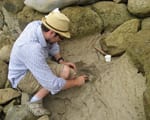
Science news reporter Stephanie Pappas covered the research of SMU Earth Sciences doctoral student Ricardo Araújo, “ Oldest dinosaur embryos ever discovered?.”
Araujo published new findings in his scientific paper published May 30 in the journal Nature, “Filling the gaps of dinosaur eggshell phylogeny: Late Jurassic Theropod clutch with embryos from Portugal.”
Araújo describes a nest of 150-million-year-old dinosaur eggs discovered in Portugal, considered to be the first eggs and embryonic material of the Jurassic’s gigantic megalosaurid theropod Torvosaurus.
EXCERPT:
By Stephanie Pappas
Fox News
A dinosaur nest discovery has revealed the most primitive known dinosaur embryos, which are among the oldest ever found.The eggs belong to Torvosaurus, a T. rex-like predator that stalked the late Jurassic some 150 million years ago. Torvosaurus grew to be around 30 feet long, but the fragmented embryos discovered in Portugal were probably only about 6 inches in length.
“This is shedding some light on the early stages of the development of these types of dinosaurs,” said Ricardo Araujo, a doctoral candidate in paleontology at Southern Methodist University in Texas.
A surprising find
The crushed clutch of eggs was found in 2005 by amateur fossil-hunter and fossil cast-maker Art Walen, who was on an annual vacation to the fossil-rich Lourinh Formation in western Portugal.“He just stumbled across some eggshells, and he traced the eggshells up the cliffs and he found there were not only isolated eggshells, there was also an entire nest up there,” Araujo told LiveScience.
Paleontologists from the Museu da Lourinh excavated the nest, which researchers first assumed belonged to a long-necked sauropod dinosaur. Even in the field, however, the paleontologists began to think they might have something very different on their hands. The eggs’ surfaces were ornamented with a strange, almost honeycomb-like pattern that was quite distinct from anything the researchers had ever seen, Araujo said.
Once the specimen was excavated and brought to the museum for preparation, the researchers got another surprise: There were embryo bones mixed in with the crushed eggs.
Such a find is “extremely rare,” Araujo said. “There’s probably a handful of situations like this in the world.”
Dinosaur development
The bones enabled the researchers to link the nest back to a specific species of dinosaur. Torvosaurus was a theropod, a group that includes both Tyrannosaurus rex and modern birds. The specimens are the earliest theropod embryos ever found.Follow SMUResearch.com on Twitter.
For more information, www.smuresearch.com.
SMU is a nationally ranked private university in Dallas founded 100 years ago. Today, SMU enrolls nearly 11,000 students who benefit from the academic opportunities and international reach of seven degree-granting schools. For more information see www.smu.edu.
SMU has an uplink facility located on campus for live TV, radio, or online interviews. To speak with an SMU expert or book an SMU guest in the studio, call SMU News & Communications at 214-768-7650.

 To book a live or taped interview with Ricardo Araújo in the SMU
To book a live or taped interview with Ricardo Araújo in the SMU  Study: High-volume Bitcoin exchanges less likely to fail, but more likely to suffer breach
Study: High-volume Bitcoin exchanges less likely to fail, but more likely to suffer breach Musicians who learn a new melody demonstrate enhanced skill after a night’s sleep
Musicians who learn a new melody demonstrate enhanced skill after a night’s sleep Study finds that newlyweds who are satisfied with marriage are more likely to gain weight
Study finds that newlyweds who are satisfied with marriage are more likely to gain weight Fruit flies fed organic diets are healthier than flies fed nonorganic diets, study finds
Fruit flies fed organic diets are healthier than flies fed nonorganic diets, study finds